- Terms And Conditions
- Privacy Policy
- Editorial Policy
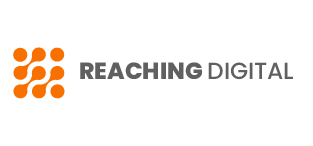
Home » 07 Best Cover Letter For First Job [Free Samples]

07 Best Cover Letter For First Job [Free Samples]
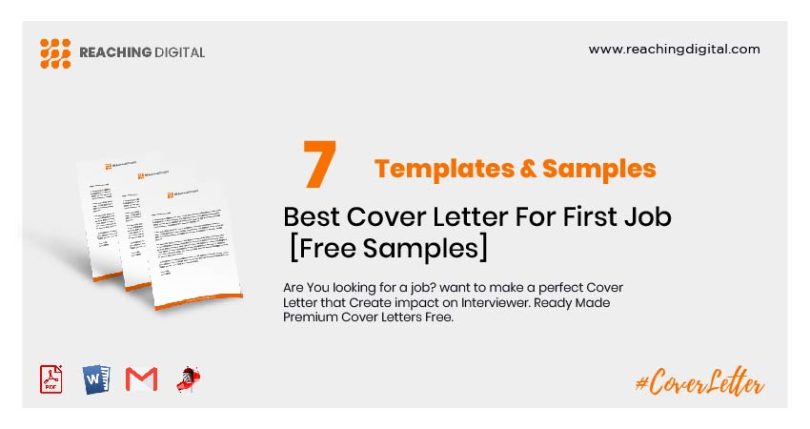
A cover letter is an important part of any job application, and your first job is no exception. While your resume may highlight your education and qualifications, a cover letter gives you the chance to tell prospective employers why you’re the perfect candidate for the position. To help you get started, we’ve created seven free cover letter templates that you can customize for your own use.
Simply choose the template that best fits your needs, and then follow the instructions to fill in your personal information and details about your experience. With a little effort, you can create a compelling cover letter that will help you land your first job. Good luck!
Table of Contents
How To Write a Cover Letter For First Job?
A cover letter is an important part of any job application, and your first job is no exception. Even if you don’t have much (or any) work experience, a well-written cover letter can give you a chance to stand out from the crowd and get your foot in the door. Here are some tips to help you write a great cover letter for your first job:
- Start by researching the company and the specific job you’re applying for. This will help you tailor your letter to the organisation and make it clear that you understand what they’re looking for.
- Next, take some time to think about what makes you a good fit for the role. What skills and experience do you have that would make you successful in the job? Be sure to mention any relevant coursework or extracurricular activities, as well as any part-time jobs you may have held.
- Once you’ve identified your key strengths, it’s time to start writing. Begin by introducing yourself and explain why you’re interested in the role. Then, use specific examples to show how your skills and experience match up with what the employer is looking for. Finally, wrap up by thanking the employer for their time and consideration.
By following these simple tips, you’ll be on your way to writing a great cover letter that will help you land your first job!
Related: How To Write a Cover Letter (And Get Hired in 2022!)
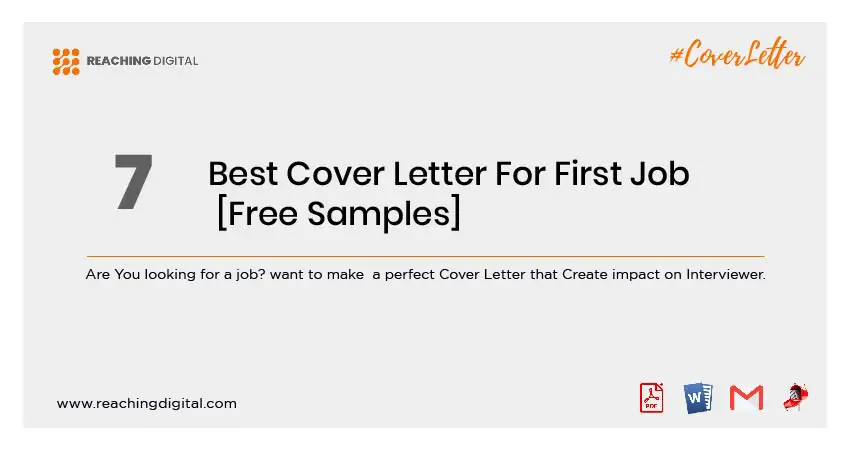
Cover Letter Examples For First-Time Teachers
Dear Hiring Manager,
As a first-time teacher, I am excited to have the opportunity to apply for a teaching position at your school. I am committed to providing my students with a high-quality education and believe that I have the skills and experience needed to be an excellent addition to your team.
In my previous role as a teaching assistant, I gained valuable experience working with students of all ages and ability levels. I am confident that I can use my skills to create a positive learning environment in your classroom.
In addition to my teaching experience, I have also completed coursework in curriculum development and instructional methods. The familiar with best practices for designing and delivering instruction and am committed to using these methods to help my students succeed.
Believe that I can be an asset to your school and am eager to put my skills to work in a new environment. I look forward to discussing my qualifications further with you and thank you for your consideration.
Related: Teacher Cover Letter:10 Examples & Sample Included
Cover Letter For First-Time Job
I am interested in the open position of ___________ at your company. Based on what I know and my research, I believe that I have the skillset required for this job.
Though I may not have previous experience working in this field, I am a fast learner and have a genuine interest in ___________. Additionally, I have _____ years of experience in customer service/sales, which I believe has helped me develop strong communication and interpersonal skills.
I would be grateful for the opportunity to discuss my qualifications and abilities further with you. Please do not hesitate to contact me at ___________ to arrange a time for an interview.
Thank you for your time and consideration.
Related: Part Time Job Cover Letter: 09 Sample Examples
Cover Letter For Teenagers First Job
To Whom It May Concern,
The writing in regards to the open position for a summer job at your company. It is a highly motivated and hardworking teenager who would love to have the opportunity to gain some valuable work experience.
Have attached my resume for your review and I am confident that you will find me to be a qualified candidate. I would appreciate the chance to come in for an interview at your earliest convenience.
Related: 107+ Unique Objective for Teenager Resume ideas & Examples
Cover Letter Examples For First Job
My name is ____________ and I am a recent graduate of ___________. I am interested in obtaining a position as a ___________ in your company.
I have enclosed my resume for your review and would appreciate any opportunity to discuss my qualifications further with you.
Enclosure: resume
Related: Generic Cover Letter: 09 Samples & Examples
Cover Letter For First Time Manager Position
I am writing to apply for the position of Manager at XYZ Company. This is my first time applying for a management position, but I believe that my qualifications and experience make me the perfect candidate for the job.
I have a degree in Business Administration from ABC University, and I have been working in customer service for the past five years. In my current role, I am responsible for handling customer complaints and ensuring that they are resolved in a timely and satisfactory manner. The have also been training new employees for the past two years.
Believe that my skills and experience will be an asset to XYZ Company. I am confident that I can successfully manage a team and meet the expectations of the company. I am eager to put my skills to work in a new environment and contribute to the success of XYZ Company.
Thank you for your consideration, and I look forward to hearing from you.
Related: 07 Best General Manager Cover Letter Samples
First-Time Supervisor Cover Letter
The writing to apply for the position of First-Time Supervisor at your company. Have a Bachelor’s degree in Business Administration and several years of experience working in customer service. The confident that I have the skills and qualifications needed to be a successful supervisor.
It is motivated, detail-oriented, and able to work well under pressure. I am also excellent at problem-solving and have a proven track record of providing excellent customer service. I am confident that I can lead a team and help contribute to the success of your company.
Thank you for your consideration, and I look forward to hearing from you soon.
Related: Data Entry Cover Letter: 07 Sample ideas
5 Things To Include In a Cover Letter For First Job
When applying for your first job, it’s important to include a well-written cover letter. The cover letter gives you an opportunity to introduce yourself and explain why you’re the perfect candidate for the job. Here are 5 things to include in your cover letter:
- Relevant experience – If you have any relevant experience, be sure to mention it in your cover letter. Even if it’s not directly related to the job you’re applying for, any experience you have will be helpful in demonstrating your skills and abilities.
- Reasons for wanting the job – In your cover letter, be sure to explain why you’re interested in the position. Include specific examples of what appeals to you about the job and the company. This will show that you’re not just applying for any old job, but that you’ve thoughtfully considered why this particular position is a good fit for you.
- Skills and qualifications – Take some time to highlight your skills and qualifications that make you perfect for the job. Even if they’re not directly related to the position, any relevant skills and qualifications will help demonstrate your suitability for the role.
- Enthusiasm – Be sure to show some enthusiasm in your cover letter! This will help demonstrate that you’re excited about the opportunity and motivated to do a great job.
- professionalism – Last but not least, remember to keep your cover letter professional throughout. Avoid using informal language or making any mistakes that could give a negative impression of you as a candidate. proofread your letter carefully before sending it off, and ask someone else to check it over too if possible.
Related: What is Cover Letter? Complete Guide To Get any Job.
When you’re applying for your first job, it’s important to put your best foot forward with a great cover letter. Not sure where to start? Check out our free samples below.
Your cover letter is your opportunity to introduce yourself to a potential employer and explain why you’re the perfect person for the job. In just a few paragraphs, you need to capture their attention and demonstrate why you’re the right candidate. This can be a challenge, especially if you don’t have much work experience.
But don’t worry – we’ve got you covered. Our free cover letter samples will give you an edge over the competition and help you land that dream job. Simply choose from one of the templates below, customize it with your own information, and you’ll be on your way to writing a winning cover letter in no time!
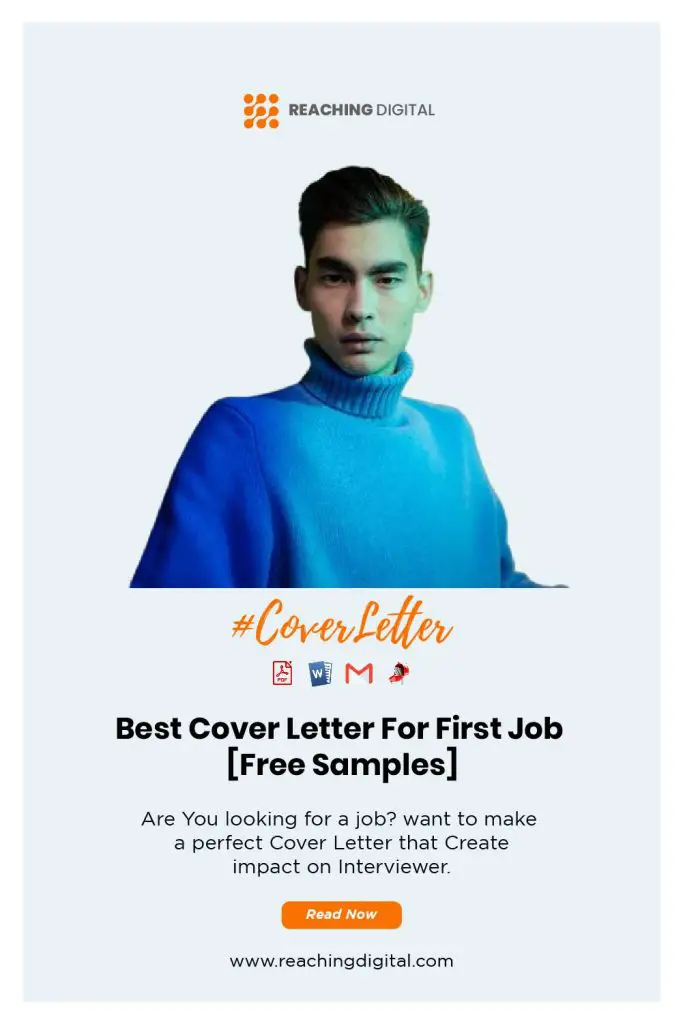
You may also like

Cover Letter for Ph.D. Application: 5 Template ideas
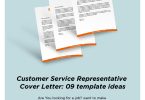
Customer Service Representative Cover Letter: 09...

Waitress Cover Letter: 07 Template Ideas

Computer Science Cover Letter: 05 Ready Template
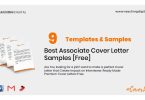
9 Best Associate Cover Letter Samples [Free]

Creative Inspiring Cover Letters: 7+ Template
About the author.
Jessica William
Leave a comment x.
Save my name, email, and website in this browser for the next time I comment.

- Resumes and Cover Letters
Cover Letter Tips For First Time Job Applicants

Table of Contents
It’s no secret: writing a good cover letter is a challenge, especially if it’s your first time. The secret? Stop obsessing! Your cover letter should be no more than a concise introduction of who you are, what you can do, and, most importantly, why you are the best fit for the job. Because really, that’s all employers want to know – at least,until you wow them during the interview, but that’s another story.
In the meantime, learn from these tips on writing a power-packed cover letter that will make them doubt, in a good way, that you’re even a first-timer:
Always the number one rule: don’t get overwhelmed. Remember, your cover letter can make a huge impact on how a potential employer views you. If it’s spotless, detailed, and interesting, you will grab some serious attention, but hopefully, that won’t be your last chance to impress. If you’re lucky enough to be called for an interview, then you can blabber your background away. But for now, the goal is to highlight your most relevant skills and abilities.
Make Your Opening Line Stand Out
As a first-time job seeker, you can’t afford an inefficient cover letter, and an efficient cover letter always opens with a standout line. Instead of saying, “I want to apply for the Medical Assistant position you advertised on XYZ,” why not go, “I want to help your hospital provide premium health care services by taking on the role of Medical Assistant.” Needless to say, your opening line sets the tone for the rest of your cover letter, so make it rock.
Tell The Truth And Prove It
If you’re going to tell them you’re the best for the position, you better back that up with solid evidence. How exactly are you the best? What can you contribute that the others cannot? Mention skills or traits that the job ad might have indicated, and give them a rundown of all your relevant credentials. But since it’s your first cover letter and you likely don’t have much experiential value to offer, emphasize your academic accomplishments instead, along with your internships, participation in student associations, and everything else that proves you’re the best for the job.
Lure Them Into Your Resume
Just before you close your cover letter, leave them with a polite but tempting call to action. For example, “I invite you to explore my resume for more details of my background.” When they do dive into your resume, make sure it can walk your talk. No matter how well-written your cover letter is, if you can’t provide details to expound each claim you’ve made, it will not help you and may even harm your chances of landing the job. An employer may require only a resume, but if they also want a cover letter, these two should always be in sync.
Stay Away From What You Don’t Have
There’s nothing wrong with not mentioning a skill or qualification you don’t have. You’re not obliged to and the last thing you want is to draw attention where you’re not the best. Instead, focus on areas where you have much to be confident about. Employers are usually flexible and realize that certain skills can be learned on the job, but of course, you need to meet the company’s standards for the core expertise required .
Make It Personal
If you really want to connect with a potential employer, give your cover letter that proverbial human touch. In short, keep it personal, but this may go beyond Googling facts about the company or adding the hiring manager’s name. For example, try actually calling them and asking for information. You can even try finding a contact who’s willing to vouch for you, and mention their name in the first paragraph of your letter. This is a great way of piquing a hiring manager’s interest. Of course, if you’re going to add a person’s name in your application, make sure you’ve checked with them beforehand.
Format Your Letter Right
Your cover letter shouldn’t only contain accurate information. It should also look polished and professional. Hence, check your formatting before putting it out. If you’re sending a traditional physical letter, observe the right business letter protocols, including adding your contact information, date, and employer’s contact information on the upper portion of the letter. If you’re sending your cover letter as an email, make sure to add a subject line with your name and the position you’re applying for. Also, cover letters are generally single-page, but if you must add more information, just adjust the margins so you don’t have to add another page. In any case, be sure to use a basic font, such as Arial and Times New Roman, and the standard font size, which is 12.
While hiring managers deal with tons of applications everyday, don’t take it as a sign that they will overlook and forgive typos. In fact, even the smallest errors can be a deciding factor because let’s face it – typos only happen when you don’t care enough to review your document thoroughly, and employers usually take that as a big red flag when considering candidates.
So don’t take anything for granted. Go through your letter and make sure it’s free of grammar or spelling errors. After you’ve scanned it a few times, ask a friend to run through it a few times more. Sometimes, it takes someone else to see your mistakes (goes for other areas in your life too). When you ask someone else to proofread your cover letter, have them give you some overall feedback as well. Do they think you’ve made your point pretty clear? While you want to sound confident, you don’t them to think you’re conceited or arrogant. Have your friends check on that as well.
Don’t forget to make sure that your heading is spot on – correct hiring manager’s name, correct company name, correct date, and all the rest. When it comes down to these details, there’s just no excuse for mistakes.
Offer Something New
This is a crucial yet often ignored point. When you write a cover letter, make it offer something that’s not already found in your resume. Of course, you can’t change the details – your background is your background, but frame your letter differently so that it still packages you as the best candidate but in a different light. This should set it apart from your resume while allowing both to each serve their specific purpose.
For instance, if you want to emphasize your skills and experience as a journalist, include in your cover letter a brief note on your most meaningful assignment as a student and how you pulled it off successfully. By adding figures, you can even show further how much value you can bring to the company. Say, you were assigned to an cover a disease epidemic in a community and educate people about mitigation measures they can do at home. To prove that you were effective in your role, you can include data that reflect a drop in the number of cases as a result of increased community awareness through your reporting. Just make sure any numbers you mention are verifiable or they will not hold water. Then again, this is a cover letter, so you need to be able to express your point as briefly yet effectively as possible.
Be Specific
One thing’s for sure – employers don’t like generic cover letters. It makes them feel you’re not serious enough about landing the job, much less doing it well when you’re finally hired. So make sure you send them a custom letter that contains the specific addressee’s name and position, the specific position you’re applying for, a specific tone to the letter that fits the nature of their business, and so on. In other words, do your research. Don’t just start tapping on your laptop without knowing the company you’re sending the letter to. They may not show it during the interview, but employers appreciate job seekers who take time out to get to know them. It says a lot about your character too, especially the kind of employee you could be.
Be Yourself
Cover letters should be professional, but you don’t have to sound cold and distant or awkwardly formal. Let your words flow – naturally. Sentences like, “I want to express my deepest desire to secure a position in your most prestigious institution” just don’t cut it, and neither will clichés that hiring managers are probably sick of anyway. Instead of saying, “problem-solver,” why not write a line or two about an actual experience where you demonstrated that trait. Sometimes, you just have to be yourself to make employers see through you, your good intentions, and, of course, the true value that you can bring to their company. And that’s only possible with simple, straightforward language.
Make Sure Your Letter Gets Read
Lastly, none of the above makes sense if your cover letter never reaches its correct destination or gets there in the wrong form. Employers can be very specific about where and how they want to receive applications, and they’re usually quick to dismiss applicants who don’t follow instructions. Attention to detail is crucial in most positions, and this is one of the first tests that you will have to pass as a job seeker. So if the job ad says only physical applications will be entertained, believe it. If you’re supposed to email your cover letter and resume as separate attachments, don’t lump the two in one document. No matter how convenient that may be for you, it’s their rules that count.
There’s no doubt that hunting for your first job can be daunting. There’s just so much to consider, especially when it comes to writing a cover letter. If you haven’t written any before, you’re probably uncertain about what to include or exclude, and how to structure your content. But there’s no reason to be intimidated as everyone has to start somewhere and employers are the first to know that. Still, that’s not an excuse for a poorly written and formatted cover letter. Even if you’re a first-timer, you’re expected to be responsible enough to know how it works.
As you try to improve your skills as a newbie job hunter, you may also find that there are many aspects unique to your situation, but there’s no need to get stuck in that vacuum. All job hunters are created equal as far as the need to leave a positive mark on hiring managers is concerned. In other words, all the classic rules still apply and will always apply, whether you’ve written a million cover letters or have only begin on your first. At some points along the way, if you feel discouraged after not receiving any favorable responses to the applications you’ve sent out, remember that this is just a phase. Maybe you just have to brush up on your overall job-hunting skills. If you persevere, you will eventually find a job that’s cut out perfectly just for you.
Incredible job here. and thank you for allowing us to witness the experiences and thoughts and work. keep up the great work. stay well. Medical and healthcare-writing-services
Leave a Reply Cancel reply
Your email address will not be published. Required fields are marked *
Save my name, email, and website in this browser for the next time I comment.
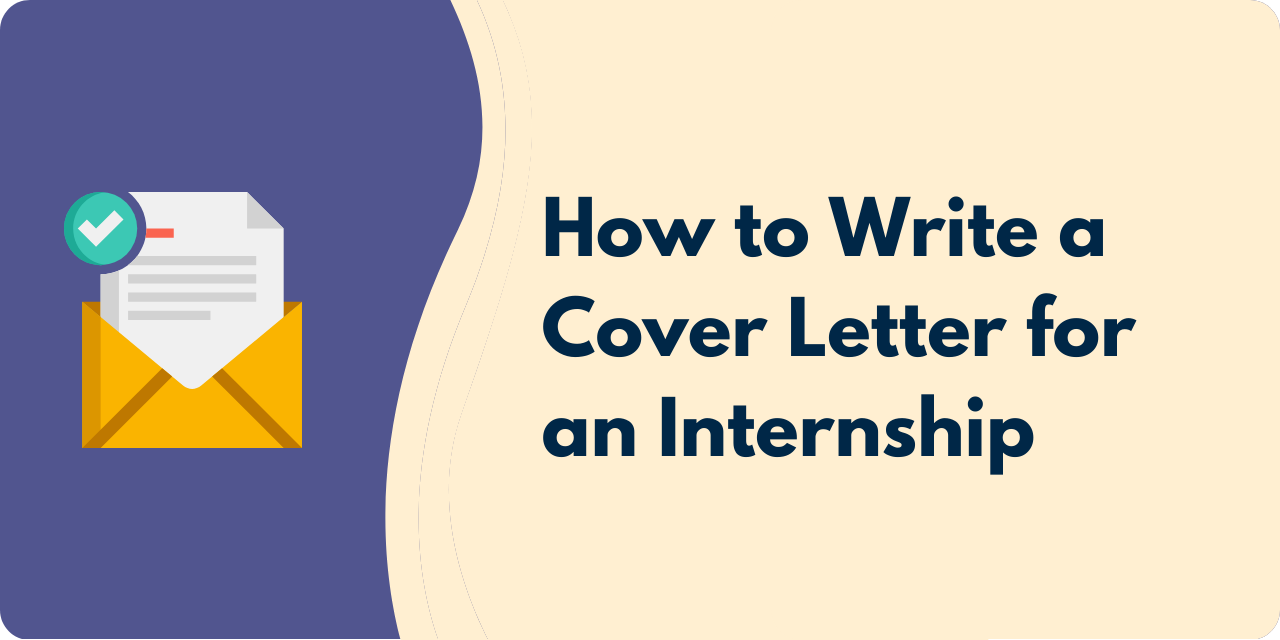
How to Write a Cover Letter For an Internship
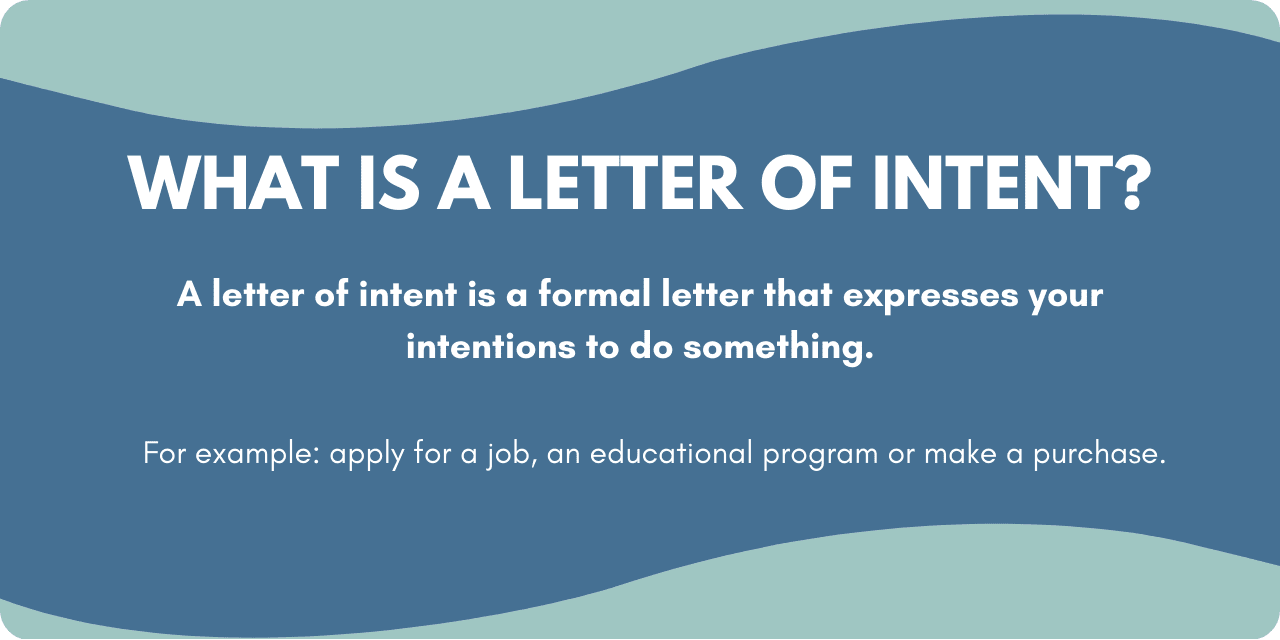
What Is a Letter of Intent & How to Write One (with Examples)
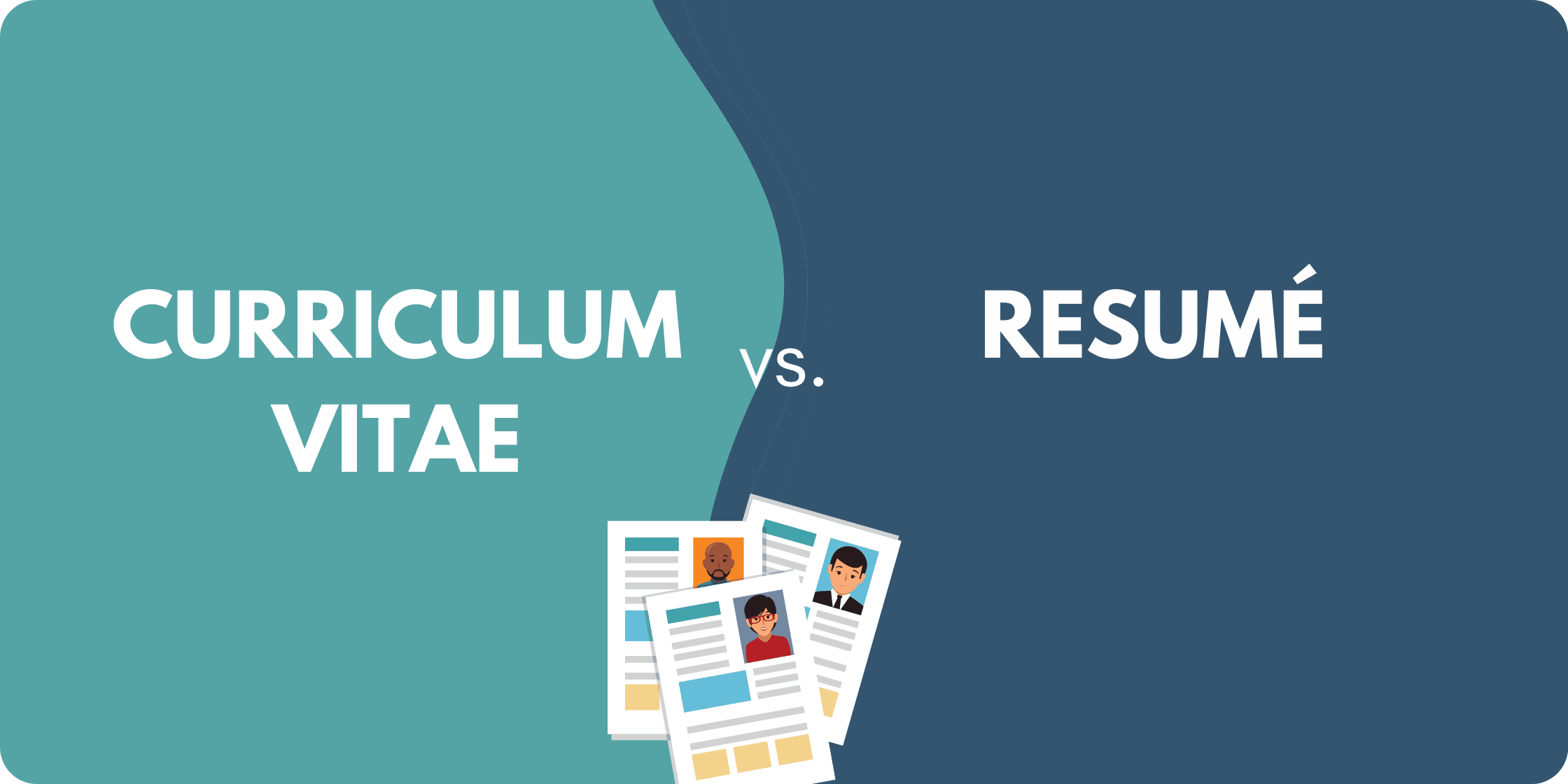
Curriculum Vitae vs a Resumé: What’s the Difference?
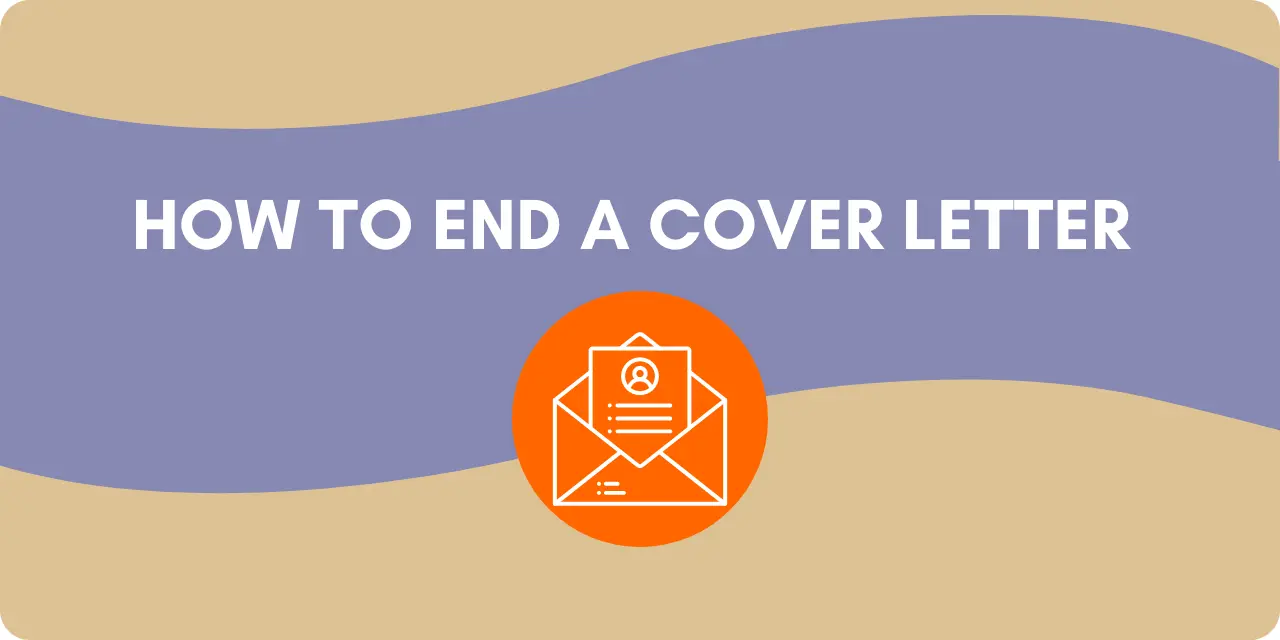
How To End A Cover Letter

Cover Letter Outline (With Examples)
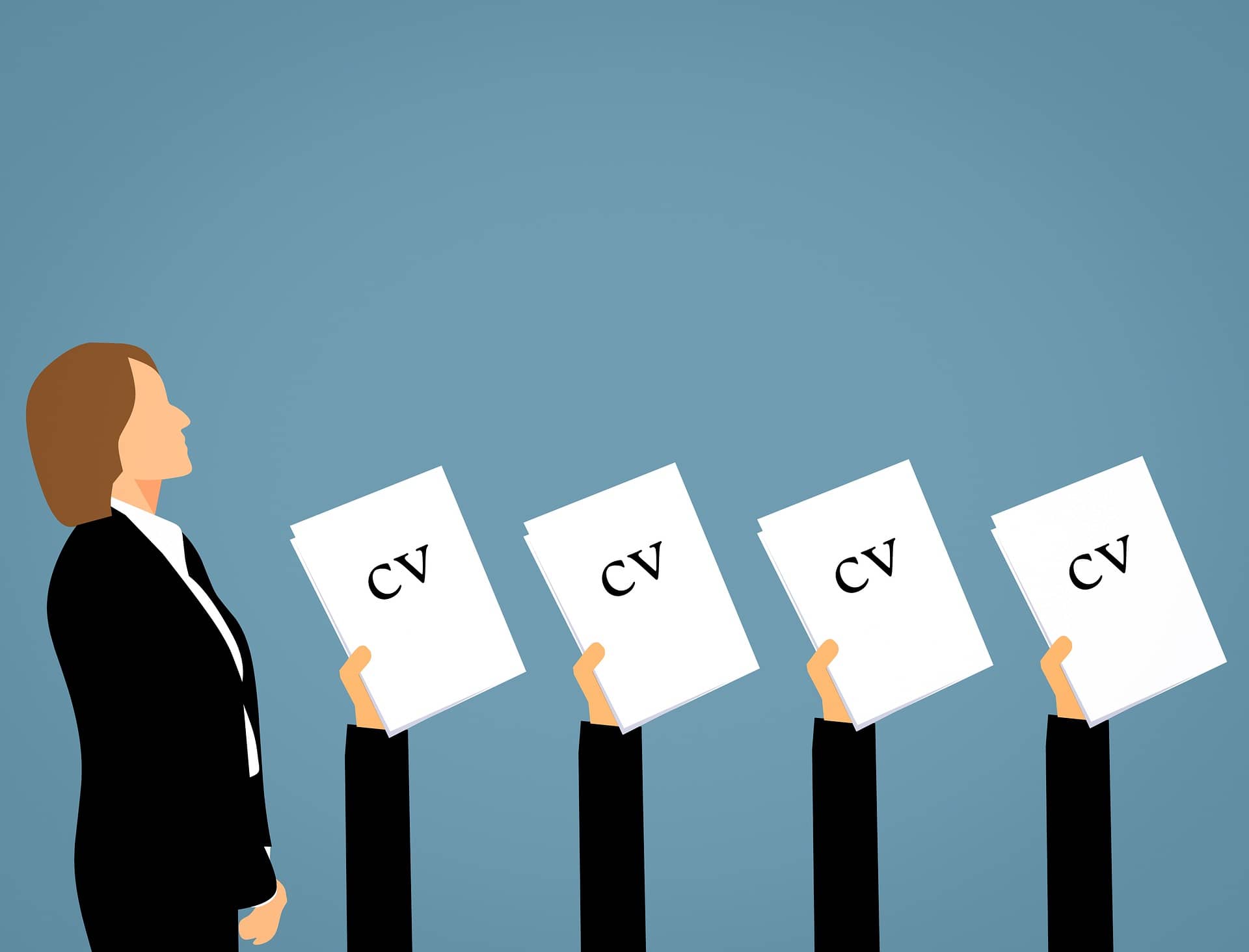
Winning Intro Sentences for Resume Cover Letters
Join the thousands who have sharpened their business writing skills with our award winning courses..
Copyright © 2024 Businesswritingblog.com.

- What is Applicant-Centric?
- Submit a Referral
- Administrative Support
- Creative & Marketing
- Customer Experience
- Digital Transformation
- Fashion & Lifestyle
- Finance & Accounting
- Human Resources
- Information Technology
- Real Estate
- Supply Chain, Operations & Logistics
- The Career Column
- 2024 Salary Guides
- Professional Coaching
- What’s a Video Resume?
- Job Seeker FAQs
- Meet Our Founder
- WBENC-Certified Organization
- Careers at Atrium
- Diversity & Inclusion
- Los Angeles
- San Francisco
- Jersey City
- Little Falls
- Are you an employer?
Cover Letters for First-Time Job Seekers
You know cover letters are important. But as a first time job seeker, you may be scratching your head as to what to write about. With undeniable inexperience in the workplace, you may feel you’re at a disadvantage. However, consider yourself lucky when it comes to writing your cover letter. You’re free from the burden of trying to wrestle with your past achievements, professional goals and somehow offer a value proposition to the firm. What you have on your side is excitement, enthusiasm and openness!
Here are a few key things to remember about cover letters and how to personalize them as a first time job seeker:
1. Tell a story.
You want to convey something personal about why you want to work at the company or enter a particular profession. Did you first fall in love with advertising when you finally understood that commercials play into our basic desires as humans driving you to create your own with your friends? Is there one particular commercial you’ll never forget? Whatever it is, you have a story to tell that is uniquely yours. Share this with the reader to grab their attention and offer something memorable.
2. Play Up Your Strengths.
While you may not have had a chance to let them shine in a professional setting, your strengths have certainly become evident in other ways. Are you a great public speaker? Do you think quickly on your feet? Maybe you learned you had these skills during the 8 th grade play when the lead froze and you shocked yourself and your class by improvising to save the show. Maybe this moment was a defining one for you – one that made it clear you wanted to further develop your public speaking skills .
3. Be authentic.
Recruiters are used to reading cover letters of more experienced candidates. Usually, they all sound relatively the same. “I’m writing to submit my resume for your Account Director role. I have been a sales leader at every organization I’ve worked for, and I’m sure to bring the same success to your firm.” Blah, Blah, Blah. Don’t feel compelled to sound too formal. While you want to remain professional, that doesn’t mean your cover letters should lack personality.
4. Never use the same cover letter twice.
Of course there are a few exceptions, but remember, the jobs may be the same but the companies are different. They have their own mission and culture. Think of it like sending a message to someone’s dating profile. Do you think you’d have more success by sending the same blanket email to all your potential dates, or by personalizing each note showing you’ve taken the time to really understand what they’re about? Show them you’ve done your research! Why do you want to work for advertising agency X as opposed to agency Y? They’re both ad agencies, but they have different clients, put out different commercials and have different creative styles. Being able to articulate why you’re specifically interested in their company will make all the difference.

A Job Seeker’s Guide to Upskilling

The Role of Mentorship in Professional Growth

Tough Love: Constructive Criticism in the Workplace

10 Things Highly Disciplined People Have in Common

Best Practices for Job Hunting in 2024

Embracing the Future: The Shift from Remote Work to Hybrid Models in 2024
Copyright © 2024 Atrium. All Rights Reserved
FOR EMPLOYERS
Copyright © 2024 Atrium.
All Rights Reserved.

How it works
For Business
Join Mind Tools
Article • 11 min read
How to Write a Great Cover Letter
Making first impressions count.
By the Mind Tools Content Team
Your dream job has opened up, at just the right time in your career! You've built up the skills and experience to take this next step, whether at your own organization or elsewhere, and you're fired up with enthusiasm.
But the deadline for applications is approaching fast. So, you update your résumé and, feeling positive about your chances, you even take your interview outfit to the dry cleaners!
Next, you sit down to write your cover letter – and your hands freeze over your keyboard. You're desperate to make a great first impression on the hiring manager, and to get your application to the top of the pile. Should the letter be formal or quirky? How much and what type of information should it contain?
In this article, we explore tips and techniques for writing a cover letter that can help you to get through to the next round of the recruitment process.
You can read the transcript of our cover letter video here .
This article gives general tips and guidance for writing a great cover letter, but there is no "one size fits all" template. After reading this article, use your own experience and judgment to decide on the best approach for the role that you are applying for, taking into account the organization's culture and best practices.
Preparing Your Cover Letter
First, you need to do some homework. Find out as much as you can about the team you are hoping to join. Start with your company's website and, if possible, the team's intranet. Then explore industry websites, journals or newsletters for news and information about the company and the industry in general.
This will help to make sure that you are fully up to date with current trends and potential pain points in your sector. You can use this information to gain a better understanding of what the team needs, and how you might be able to help.
Your cover letter needs to find the right tone, one that reflects the culture of your organization. Chances are, you're already familiar with this. But different teams and departments may have different ways of working. For example, do they have a formal, reserved approach, or a more relaxed and informal feel?
Next, look at your résumé from the hiring manager's point of view. Does it include anything that might concern them? For example, are there any gaps in your work history? Your cover letter should include brief explanations for these, such as taking a career break to raise your family.
If your résumé needs more than just a quick refresh, or you need to create one from scratch, you can find out how to do this with our article, Writing Your Résumé (CV) .
Cover Letter Basics
If you were meeting a potential boss for the first time, chances are you'd take extra care with your appearance. If you pay the same attention to your cover letter, that meeting will more likely take place! So, check and double check the following areas:
- Spelling and grammar: these mistakes are easily avoidable. A cover letter with spelling mistakes or missing words looks careless and unprofessional. Use a dictionary! Ask someone else to read your letter, too, as a "fresh pair of eyes" can pick up errors that you've missed. Reading it aloud can also help to ensure that the letter "flows."
- Consistency: for example, if you capitalize one job title – say, Marketing Executive – capitalize all the others, too. Our article, Encouraging Attention to Detail , has strategies for maintaining high standards of work.
- Confidence: avoid saying that you "believe" or "feel" that you are the right person for the job. Have the courage of your convictions and say that you know you are right for it.
- Jargon and clichés: use the correct technical terms where appropriate, but bear in mind that the first person to read your letter may be an HR manager, rather than the team leader or other expert. Also, jargon and acronyms can mean different things in different teams or businesses, so they could cause confusion. Similarly, avoid meaningless, over-used phrases such as "people person" or "thinking outside the box."
Writing a Compelling Cover Letter
Chances are, you're not the only person who sees the role as a dream opportunity. It may have attracted numerous applications. That means the hiring manager has to sift through a lot of cover letters, so they will want to see at a glance what you have to offer.
Brevity is key. As writer and editor Lily Herman instructs , "Keep it short (like, really short). Your cover letter should be a single page (no more!) and around 300-350 words."
Read our articles, Writing Skills and Keep It Simple , for guidance on getting your message across clearly and concisely.
Consider the following structure as a guide for your cover letter:
1. Introduce Yourself
Grab the reader's interest with your opening paragraph. In one or two sentences, tell them who you are, and why they should hire you, and express your enthusiasm for the role.
For example, you could say, "As a sales manager with six years' experience of motivating my team and exceeding my targets each quarter, I was excited to see your advertisement for regional sales director." This sounds much more appealing than, "I am writing to apply for the role of regional sales director, which was advertised on LinkedIn."
2. Explain Why You Are the Best Candidate
Next, describe what you can bring to the role. Give examples of skills that you've developed or successes that you've enjoyed that are relevant to the job description.
Be specific, and quantify your achievements wherever possible. If you've exceeded your sales targets, for example, give a percentage or monetary figure. Tell the truth, and don't be tempted to exaggerate or embellish your accomplishments – it's unethical, and will backfire if you are caught out.
3. Be Enthusiastic About the Role
You may have the qualifications and the experience to do the job, but employers also want to know that you feel passionate about the role and their organization. Describe why the company or department appeals to you. For example, you could explain that you share its values . This signals that you'll be engaged, committed, and likely to stick around.
4. Summarize and Request a Follow-Up
Finally, round up what you've written, and indicate your availability for interview. A strong closing paragraph could be, "I've always delivered outstanding results, and I've enjoyed every challenge that has come my way. I'd be delighted to meet with you and discuss the value that I can add to your team."
Formatting Your Cover Letter
Format your cover letter as though you were going to send it in the mail, even if you're sending it by email. This will make it look more professional.
Here's a point-by-point guide for laying out your cover letter:
- Write your name and address at the top of the page. Align it to the right.
- Write the name and address of the prospective employer. Align it to the left.
- Add the date of your letter under the employer's address, and align it to the left. Leave a line space between the address and the date.
- Begin your letter with "Dear…" and the name of the hiring manager. Avoid "To whom it may concern." If you don't know who to address the letter to, send the HR department an email asking for the appropriate recipient.
- Use a font that's clear and easy to read, such as Arial or Helvetica, with a type size of 10 or 12 points.
- Space your paragraphs, keep wide margins, and don't crowd the page.
- Leave a line space under the final paragraph, and sign off with "Yours sincerely" or "Best regards." Leave a couple of line spaces under the signoff, and then sign your name, typing it in full beneath your signature. If you are sending the letter digitally, it's not necessary to actually sign it – just type your name instead.
Consider sending your cover letter as a PDF file. PDFs are compatible with most computers and devices, so it should look the same on the recipient's screen as it does on your own.
Beware of These Cover Letter Pitfalls
Here are a few mistakes to avoid when writing a cover letter:
- Making jokes. Avoid doing this, because humor is highly subjective, and can be easily misunderstood.
- Mentioning your current salary, or salary expectation. Don't do this unless the job advertisement asks for it. This type of information is best left until you are able to negotiate a job offer .
- Copy and pasting. Of course, to a certain extent cover letters for different applications will overlap. But make sure that your cover letter is clearly written with the job you're applying for in mind – not a simple copy and paste with a few tweaks.
Your cover letter needs to show the recruiting manager that you're the right person for the job, and that you will be a good fit for the team. Research the role carefully, and pay attention to the tone and language that you use.
Your letter should fit on one page, and be presented in a way that's easy to read. It should follow this structure:
- Introduce yourself.
- Explain why you are the best candidate.
- Be enthusiastic about the role.
- Summarize and say that you are available for interview.
Try to give real examples that demonstrate your skills, or that show how you added value to your team or organization. But tell the truth! Don't exaggerate or embellish your accomplishments.
Finally, remember to check your letter carefully for mistakes, and then check it again.
Herman, L. (2016). '16 Secrets for Writing Cover Letters That Get You Hired,' Motto , February 26, 2016. Available here .
You've accessed 1 of your 2 free resources.
Get unlimited access
Discover more content
Infographic
Delivering Great Feedback Infographic
Infographic Transcript
The Situation-Behavior-Impact™ Feedback Tool
Providing Clear, Specific Feedback
Add comment
Comments (0)
Be the first to comment!

Team Management
Learn the key aspects of managing a team, from building and developing your team, to working with different types of teams, and troubleshooting common problems.
Sign-up to our newsletter
Subscribing to the Mind Tools newsletter will keep you up-to-date with our latest updates and newest resources.
Subscribe now
Business Skills
Personal Development
Leadership and Management
Member Extras
Most Popular
Newest Releases

SWOT Analysis

SMART Goals
Mind Tools Store
About Mind Tools Content
Discover something new today
How to stop procrastinating.
Overcoming the Habit of Delaying Important Tasks
What Is Time Management?
Working Smarter to Enhance Productivity
How Emotionally Intelligent Are You?
Boosting Your People Skills
Self-Assessment
What's Your Leadership Style?
Learn About the Strengths and Weaknesses of the Way You Like to Lead
Recommended for you
How to reboot your career video.
Video Transcript
Business Operations and Process Management
Strategy Tools
Customer Service
Business Ethics and Values
Handling Information and Data
Project Management
Knowledge Management
Self-Development and Goal Setting
Time Management
Presentation Skills
Learning Skills
Career Skills
Communication Skills
Negotiation, Persuasion and Influence
Working With Others
Difficult Conversations
Creativity Tools
Self-Management
Work-Life Balance
Stress Management and Wellbeing
Coaching and Mentoring
Change Management
Managing Conflict
Delegation and Empowerment
Performance Management
Leadership Skills
Developing Your Team
Talent Management
Problem Solving
Decision Making
Member Podcast

12 Writer Cover Letter Examples
Writers excel at weaving words into captivating stories, painting vivid pictures with their prose, and engaging readers with their narrative. Similarly, your cover letter is your chance to craft a compelling narrative about your professional journey, using your words to captivate recruiters and paint a vivid picture of your skills and experiences. In this guide, we'll explore outstanding Writer cover letter examples to help you pen your own captivating professional story.

Cover Letter Examples
Cover letter guidelines, writer cover letter example, senior writer cover letter example, freelance writer cover letter example, creative writer cover letter example, ux writer cover letter example, blog writer cover letter example, curriculum writer cover letter example, proposal writer cover letter example, resume writer cover letter example, grant writer cover letter example, staff writer cover letter example, contributing writer cover letter example, how to format a writer cover letter, cover letter header, what to focus on with your cover letter header:, cover letter header examples for writer, cover letter greeting, get your cover letter greeting right:, cover letter greeting examples for writer, cover letter introduction, what to focus on with your cover letter intro:, cover letter intro examples for writer, cover letter body, cover letter body examples for writer, cover letter closing, what to focus on with your cover letter closing:, cover letter closing paragraph examples for writer, pair your cover letter with a foundational resume, cover letter writing tips for writers, showcase your writing skills, personalize your letter, highlight relevant experience, keep it brief, proofread thoroughly, cover letter mistakes to avoid as a writer, overloading with information, using generic language, not tailoring the letter to the job, ignoring the company's culture, not proofreading, cover letter faqs for writers.
The best way to start a Writer cover letter is with a compelling hook that grabs the reader's attention. This could be a brief anecdote about a writing achievement, a unique perspective you bring to your work, or a notable publication where your work has been featured. Follow this with a clear statement of your intent, such as the specific role you're applying for. Remember to address the letter to the appropriate person, if their name is available. This personalized and engaging approach will help you stand out from other applicants.
Writers should end a cover letter by summarizing their interest in the position and expressing gratitude for the reader's time. They should reiterate their unique skills or experiences that make them a good fit for the role. It's also important to include a call to action, such as a request for an interview or a meeting. The closing should be professional and polite. Here's an example: "I am excited about the opportunity to bring my unique storytelling skills to your team and I am confident that I can contribute to your editorial goals. Thank you for considering my application. I look forward to the possibility of discussing this opportunity with you further." Finally, they should sign off with a professional closing like "Sincerely" or "Best regards," followed by their full name.
A writer's cover letter should ideally be one page long. This is because the purpose of a cover letter is to provide a brief introduction of yourself and to explain the reasons for your interest in the specific position or organization. It's important to be concise and to the point, while effectively communicating your skills, experiences, and why you would be a good fit for the role. A one-page cover letter is usually sufficient to achieve this. If it's too long, there's a risk that the hiring manager might not read the entire letter, and if it's too short, it might not provide enough information about your qualifications.
Writing a cover letter with no experience as a writer can seem daunting, but it's important to remember that everyone starts somewhere. Here's a step-by-step guide on how to approach it: 1. Start with a strong introduction: Begin your cover letter by introducing yourself and stating the position you're applying for. Make sure to grab the reader's attention with your enthusiasm for the role and the company. 2. Highlight your relevant skills: Even if you don't have direct writing experience, you likely have other skills that are relevant. Perhaps you have strong research skills, creativity, or a knack for storytelling. Maybe you've written blog posts, social media content, or academic papers. All of these can be valuable in a writing role, so be sure to highlight them. 3. Showcase your knowledge about the company: Show that you've done your homework about the company and the industry. This can demonstrate your interest and your initiative, both of which are attractive qualities in a potential hire. 4. Discuss your education: If you've taken any writing-related courses or earned a degree in a related field (like English, journalism, or communications), be sure to mention it. Even if your education isn't directly related, discuss how it's helped you develop valuable skills. 5. Provide examples: Use specific examples to demonstrate your skills. For instance, if you're applying for a content writing role, you might discuss a time when you wrote a well-received research paper or a blog post. 6. Show your passion: Passion can often make up for a lack of experience. If you're passionate about writing, make sure that comes across in your cover letter. 7. Close with a strong conclusion: Wrap up your cover letter by reiterating your interest in the role and your eagerness to contribute to the company. Thank the reader for considering your application and express your hope for further discussion. 8. Proofread: This is especially important for a writing role. Make sure your cover letter is free of typos and grammatical errors. Remember, everyone has to start somewhere. Even if you don't have professional writing experience, your unique skills and perspectives can still make you a strong candidate. Good luck!
Related Cover Letters for Writers
Content writer cover letter.

Copywriter Cover Letter

Editor Cover Letter

Journalist Cover Letter

Technical Writer Cover Letter

Digital Marketing Specialist Cover Letter

Writer Cover Letter

Senior Writer Cover Letter
Freelance writer cover letter, creative writer cover letter, ux writer cover letter, blog writer cover letter, curriculum writer cover letter, proposal writer cover letter, resume writer cover letter, grant writer cover letter, staff writer cover letter, contributing writer cover letter, related resumes for writers, writer resume example.

Try our AI-Powered Resume Builder
Social Worker Cover Letter Example (W/ Templates & Tips for 2024)

You've come a long way from when you first realized you wanted to help people and improve their lives.
Your dedication to understanding and helping others has been the driving force behind your journey to becoming a social worker. That passion that prompted late-night studies and countless hours of fieldwork is finally about to pay off.
However, there's just one tiny obstacle that's proving to be more challenging than you expected: crafting an attention-grabbing social worker cover letter.
Facing the empty page that should show off your dedication, skills, and the difference you aim to make feels a bit like navigating the complexities of a case without any background information.
But worry not!
In this article, we’re going to guide you through the steps you should take to represent your social work prowess on paper.
Here’s what we’ll cover:
Social Worker Cover Letter Example
- 5 Steps to Writing an Impactful Social Worker Cover Letter
- 3 Essential Social Work Cover Letter Tips
...and so much more!
Let's dive right in!

5 Steps for the Perfect Social Worker Cover Letter
So, you've just read a social worker cover letter that seals the deal.
Ready to write your own stellar cover letter ? Just follow the steps below:
#1. Put Contact Information in the Header
Kick off your cover letter with your contact information and position it at the header, much like how you'd set it up on your resume .
Here’s what to include:
- Full Name: Start by listing your first name and surname right at the top.
- Professional Title: Align the title on your cover letter with the specific social worker position you're eyeing. The hiring manager is likely going through stacks of applications for various roles, so it’s super helpful when you're clear about the specific role you're applying for.
- Email Address: Go for a professional email address, ideally a mix of your first and last name. Remember, that fun email from your teen years? Maybe not the best pick here. So, while "[email protected]" might give someone a chuckle, it's better to stick with something like "[email protected]."
- Phone Number: Write down your phone number correctly and if you're branching out to international roles, make sure to add the dial code too.
- Location: Your city and state or country generally cover it. But if you’re on the hunt for remote roles or you're eyeing a big move, make that known.
- Relevant Links (Optional): You might want to include any fitting websites, publications, or profiles, like your LinkedIn .
Now, it’s time to list the hiring manager's details.
Here’s your go-to list:
- Organization Name: Pen down the name of the agency, nonprofit, or institution you're reaching out to.
- Hiring Manager’s Name: If you can dig it up, list the name of the hiring manager or department head. A quick peek at the job post, the organization’s site, or LinkedIn might give you the scoop.
- Hiring Manager’s Title: Found the right person? If you see they are the "Director of Child Welfare Services," for example, use that specific title. It’s a bit more personal than calling them the generic "Hiring Manager."
- Location: Stick to the city and state or country, especially if they have multiple locations. If you want to add a bit more detail, the street address works.
- Email Address (Optional): If you've found the hiring manager’s email, it’s a neat detail to add.
- Date of Writing (Optional): Dropping in the date you crafted your cover letter adds that sprinkle of professionalism.
Here’s a bunch of cover letter examples to check that can further inspire you to craft the perfect cover letter.
#2. Address the Hiring Manager
After jotting down all the essential contact details, it’s time to address the hiring manager .
How you address your cover letter can add a personal touch to your cover letter and make you a more memorable candidate.
Kick things off with a bit of detective work. Scope out the job posting, the company's website, or LinkedIn to unearth the hiring manager for the social work role you're eyeing. This can help you find their name and perhaps even their email.
Then, keep things polite and professional - but steer clear from the age-old "To Whom It May Concern," though. That's so last century! It's typically a good move to use "Ms." or "Mr.," followed by their surname. But if you're in the dark about their gender or marital status, just write down their entire name. For instance:
- Dear Mr. Rodriguez,
- Dear Jordan Rodriguez,
Hit a dead-end and can't unearth details about the hiring manager or the head of the social work team?
No stress!
Simply address your letter to the broader department or the organization as a whole:
- Dear Social Work Department,
- Dear Social Work Hiring Crew,
- Dear Human Resources Selection Team,
- Dear Chief of Social Work,
#3. Write an Eye-Catching Opening Statement
Selection committees often spend only about seven seconds skimming a social work applicant's materials before determining its worth for a more thorough review.
That's why it's paramount to make a striking first impression with your social worker cover letter.
Kickstart your letter by introducing yourself and stating precisely why you're drawn to the position. Highlighting your genuine passion for the field and the specific role can captivate the hiring manager.
Another smart move is to familiarize yourself with the organization or agency you're applying to. The more insights you have about them, the better you can emphasize your alignment with their mission and values. This thoughtful approach indicates to the selection committee that you're not just scattering applications in the wind, but are genuinely vested in this particular role.
Depending on your professional experience in social work, you might want to lead with a significant contribution you've made or underline the skills that earmark you as the ideal candidate for the role.
However, keep things concise. Your aim should be to ignite the hiring manager’s interest, prompting them to explore the entirety of your cover letter without overwhelming them from the get-go.
#4. Use the Cover Letter Body for the Details
The body of your cover letter is where you can delve into detail about what makes you the right fit for the role.
It's essential here to refrain from merely echoing your social worker resume . This part should vividly display your expertise in social work and the unique strengths you bring to the table. Your primary goal is to assure the hiring manager that you're not just another candidate but the right fit for their team.
Reference any significant interventions, cases, or community programs you've been a part of, and anchor these experiences to the specifics of the job posting.
One way to do this is by checking the job listing. If the role emphasizes trauma-informed care, child welfare, or substance abuse counseling, for instance, highlight your experiences and skills in those areas rather than other unrelated experiences.
Being well-informed about the organization’s objectives, community initiatives, or therapeutic approach can be advantageous. If you've had experiences or training that align with their methodologies or have a familiarity with the populations they serve, highlight that. This underscores your genuine interest and how you resonate with their organizational ethos and mission.
Lastly, let your passion for social work and helping others come through. Emphasize your eagerness for the role and your firm belief in making a meaningful difference through your specific skills and insights.
Make sure to also avoid these common cover letter mistakes at all costs while you’re at it!
#5. Wrap It Up and Sign It
Concluding your cover letter with finesse can make all the difference for an aspiring social worker.
It's pivotal to ensure that your closing remarks reaffirm the positive impression you've worked hard to build throughout your letter. You wouldn't want the hiring manager second-guessing any of the valuable points you've made.
In your conclusion, confidently reiterate the reasons that make you an ideal candidate for the social work role, or highlight those experiences that distinctly set you apart from others in the field.
Following your recap, usher in a call to action. Encourage the hiring manager to talk in more detail about how you’d be a perfect fit for the organization. This proactive approach can increase your chances of securing an interview.
Finally, wrap up your letter with an air of professionalism. Opt for a fitting valediction, then pen down your full name. Here’s an example:
I'm available at the listed email or contact number to discuss any further details or set up an interview. I eagerly await an opportunity to explore my candidacy more comprehensively at your convenience.
Warm regards,
If you feel "Warm regards" is commonplace, here are a few alternatives to consider:
- Yours sincerely,
- With appreciation,
- In gratitude,
- Thank you for your time and consideration,

3 Essential Social Worker Cover Letter Tips
Now that you're armed with the basics of crafting a standout cover letter, let's dive into some key cover letter tips tailored specifically for social workers to give yours that extra shine:
#1. Match Your Resume
When you're in the process of applying for a role as a social worker, it's crucial to keep your application consistent - both visually and in terms of content.
That’s why we recommend your resume and cover letter match each other as much as possible, especially in terms of formatting and layout.
If they don't, you might come across as messy and unstructured.
It's important to neatly align your text and contact information on your cover letter and make sure you’re using the same font size and style in both documents. Be attentive to things like margins and line spacing too.
Lastly, always aim to keep your cover letter within a single page - just like you would your resume.
Or Use A Cover Letter Template Instead
Short on time? No stress.
Use our free resume builder to create the perfect social worker resume.
Then pick a matching cover letter template to save time and effort.
All of our templates are made with the help of hiring managers from around the globe, ensuring every detail fits industry standards. So, besides saving time, you're adding a professionally designed, matching cover letter to your resume. It's a win-win!

#2. Be Enthusiastic
Now, let's talk about enthusiasm. It can shift the whole dynamic of your cover letter, and it's simpler to transmit than you might think.
Contrary to popular belief, an enthusiastic cover letter doesn't mean lavishing the company you're applying to with over-the-top compliments. Really, it's all about projecting a positive and passionate attitude about your role as a social worker.
Enthusiasm within a cover letter is important for a number of reasons. Hiring managers often use it as a barometer to gauge your personality and your genuine interest in the job. When they read your cover letter and see how excited you are, they are more likely to see you as a motivated candidate who truly values the role of a social worker.
By portraying passion and excitement about your work, you indirectly show a dedicated and positive approach to your profession. This can distinguish you from other candidates who may view the job simply as a means to an end.
However, while enthusiasm is critical, remember not to tip the balance towards arrogance. Your confidence should not translate into overconfidence. Avoid excessive self-praise or flattery towards the company.
#3. Be Formal
Professionalism is key when it comes to cover letters, and adopting a formal tone is a big part of that. But remember, being formal doesn't mean being stiff or robotic - it merely stands for being respectful, clear, and concise in your communication.
Maintaining a formal tone in your cover letter grants an air of professionalism to your application. It shows that you understand and respect the norms and conventions in a professional setting. This contributes to painting a positive image of you as an applicant, increasing your chances of securing a position as a social worker.
A formal tone communicates to the employer that you've taken the time to carefully craft the letter and you value the opportunity to apply for the job. It sends the message that you're not taking this lightly and that you've made a serious effort.
For the best impression, aim for a cover letter that is structured, clear, respectful, and shows you’re serious about the role - but without falling into the pitfalls of being either overly formal or impersonal. Juggle your words wisely, and you'll give the hiring managers exactly what they're looking for.
Key Takeaways
And that’s a wrap on the perfect social worker cover letter! We hope our example will inspire you to create one that helps you secure your dream position right away.
Before you begin drafting your letter, here are some key takeaways from the article:
- Start your social worker cover letter by including your contact information and that of the hiring manager. Double-check that your details are accurate to make sure the hiring manager can contact you for an interview.
- Craft an engaging opening paragraph in your social worker cover letter to capture the hiring manager's attention and encourage them to read further.
- In the body of your cover letter, elaborate on your significant achievements and relevant skills for the position you're applying for.
- Include a call to action at the end of your social worker cover letter to prompt the hiring manager to contact you or schedule an interview.
- Lastly, verify that your social worker resume and cover letter match in terms of style and visual appearance. If you're short on time to ensure consistency, consider selecting one of our resume templates and a matching cover letter template.

To provide a safer experience, the best content and great communication, we use cookies. Learn how we use them for non-authenticated users.
Support Worker cover letter examples
Are you looking for your next role as a support worker?
Then you need a strong cover letter that’s going to secure you an interview.
But we understand that you’re always on hand to support others, so now it’s our turn to support you.
Let us help you find your dream job by creating a standout application. Check out our top tips and support worker cover letter examples below for guidance.
CV templates
Support Worker cover letter example 1
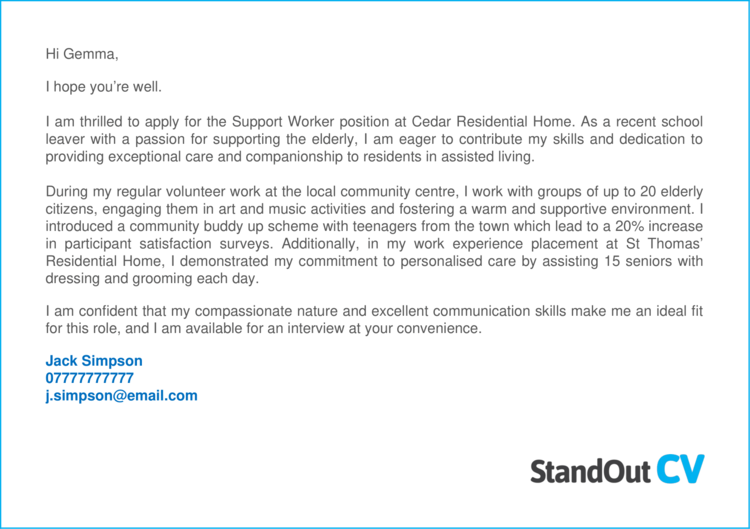
Support Worker cover letter example 2
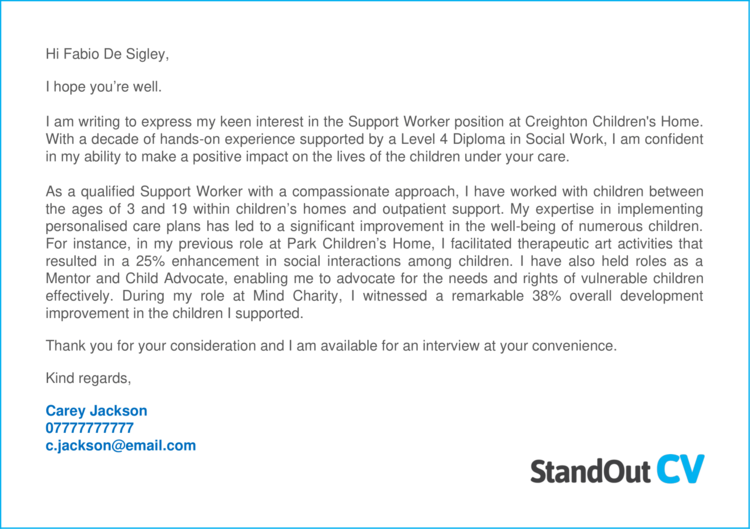
Support Worker cover letter example 3
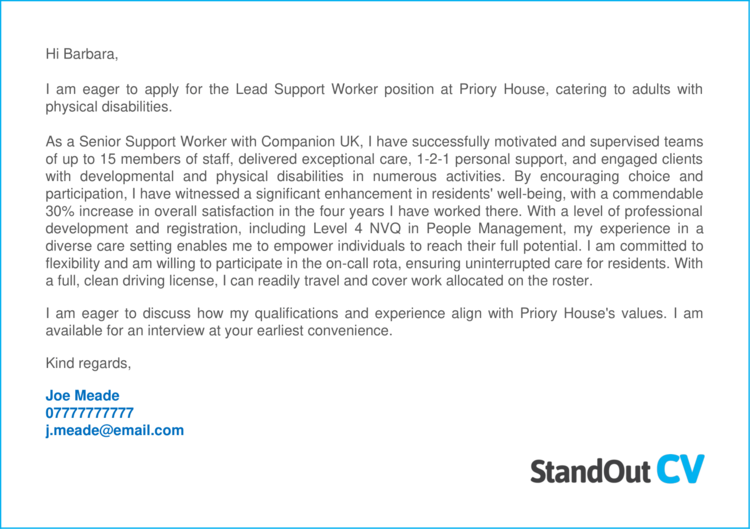
The Support Worker cover letter examples above should give you a good idea of the type of content you need to include in your own cover letter, and how it should be structured.
But if you’re really looking to wow recruiters and get your CV in front of the very best employers, then check out our guidance on how to write your own effective cover letter below.
How to write a Support Worker cover letter
Here’s how you can write your own eye-catching cover letter, broken down into simple steps.

Write your cover letter in the body of an email/message
When writing your Support Worker cover letter, it’s best to type the content into the body of your email (or the job site messaging system) and not to attach the cover letter as a separate document.
This ensures that your cover letter gets seen as soon as a recruiter or employer opens your message.
If you attach the cover letter as a document, you’re making the reader go through an unnecessary step of opening the document before reading it.
If it’s in the body of the message itself, it will be seen instantly, which hugely increases the chances of it being read.

Start with a friendly greeting

To kick your cover letter off, start with a friendly greeting to build rapport with the recruiter instantly.
Your greeting should be personable but professional. Not too casual, but not too formal either
Go with something like…
- Hi [insert recruiter name]
- Hi [insert department/team name]
Avoid old-fashioned greetings like “Dear sir/madam ” unless applying to very formal companies.
How to find the contact’s name?
Addressing the recruitment contact by name is an excellent way to start building a strong relationship. If it is not listed in the job advert, try these methods to find it.
- Check out the company website and look at their About page. If you see a hiring manager, HR person or internal recruiter, use their name. You could also try to figure out who would be your manager in the role and use their name.
- Head to LinkedIn , search for the company and scan through the list of employees. Most professionals are on LinkedIn these days, so this is a good bet.
Identify the role you are applying for
Once you’ve opened up the cover letter with a warm greeting to start building a relationship, it is time to identify which role you want to apply for.
Recruiters are often managing multiple vacancies, so you need to ensure you apply to the correct one.
Be very specific and use a reference number if you can find one.
- I am interested in applying for the position of Support Worker with your company.
- I would like to apply for the role of Sales assistant (Ref: 406f57393)
- I would like to express my interest in the customer service vacancy within your retail department
- I saw your advert for a junior project manager on Reed and would like to apply for the role.
See also: CV examples – how to write a CV – CV profiles
Highlight your suitability
The bulk of your cover letter should be focused around highlighting your suitability for the job you are applying to.
Doing this will show the recruiter that you are suitable candidate and encourage them to open your CV.
The best way to do this, is by studying the job advert you are applying to, and find out what the most important skills and knowledge are.
Once you know the most important requirements, you then need to highlight your matching skills to the recruiter. In a few sentences, tell them exactly why you are a good fit for the job and what you can offer the company.

Keep it short and sharp
It is best to keep your cover letter brief if you want to ensure you hold the attention of busy recruiters and hiring managers. A lengthy cover letter will probably not get read in full, so keep yours to around 3-6 sentences and save the real detail for your CV.
Remember the purpose of your cover letter is to quickly get recruiters to notice you and encourage them to open your CV, so it only needs to include the highlights of your experience.
Sign off professionally
To round of your CV, you should sign off with a professional signature.
This will give your cover letter a slick appearance and also give the recruiter all of the necessary contact information they need to get in touch with you.
The information to add should include:
- A friendly sign off – e.g. “Kindest regards”
- Your full name
- Phone number (one you can answer quickly)
- Email address
- Profession title
- Professional social network – e.g. LinkedIn
Here is an example signature;
Warm regards,
Jill North IT Project Manager 078837437373 [email protected] LinkedIn
Quick tip: To save yourself from having to write your signature every time you send a job application, you can save it within your email drafts, or on a separate documents that you could copy in.

What to include in your Support Worker cover letter
So, what type of information should you write about in your Support Worker cover letter?
The specifics will obviously depend on your profession and the jobs you are applying to, but these are the key areas you should be covering.
- Your industry experience – Tell recruiters the types of companies you have been working for and the roles you have held in the past.
- Your qualifications – Highlight your most important relevant qualifications to show employers you are qualified to do the roles you are applying for.
- The impact you have made – Demonstrate the positive impact you have made for employers in previous jobs. Have you saved money? Improved processes? Made customers happy?
- Your reasons for moving – Employers will want to know why you are leaving your current/previous role, so provide them with a brief explanation here.
- Your availability – When will you be able to start a new job ? Check your current contract to find out your notice period if you are in a position already.
Support Worker cover letter templates
Copy and paste these Support Worker cover letter templates to get a head start on your own.
I hope you’re well.
I am thrilled to apply for the Support Worker position at Cedar Residential Home. As a recent school leaver with a passion for supporting the elderly, I am eager to contribute my skills and dedication to providing exceptional care and companionship to residents in assisted living.
During my regular volunteer work at the local community centre, I work with groups of up to 20 elderly citizens, engaging them in art and music activities and fostering a warm and supportive environment. I introduced a community buddy up scheme with teenagers from the town which lead to a 20% increase in participant satisfaction surveys. Additionally, in my work experience placement at St Thomas’ Residential Home, I demonstrated my commitment to personalised care by assisting 15 seniors with dressing and grooming each day.
I am confident that my compassionate nature and excellent communication skills make me an ideal fit for this role, and I am available for an interview at your convenience.
Kind regards,
Jack Simpson
Hi Fabio De Sigley,
I am writing to express my keen interest in the Support Worker position at Creighton Children’s Home. With a decade of hands-on experience supported by a Level 4 Diploma in Social Work, I am confident in my ability to make a positive impact on the lives of the children under your care.
As a qualified Support Worker with a compassionate approach, I have worked with children between the ages of 3 and 19 within children’s homes and outpatient support. My expertise in implementing personalised care plans has led to a significant improvement in the well-being of numerous children.
For instance, in my previous role at Park Children’s Home, I facilitated therapeutic art activities that resulted in a 25% enhancement in social interactions among children. I have also held roles as a Mentor and Child Advocate, enabling me to advocate for the needs and rights of vulnerable children effectively. During my role at Mind Charity, I witnessed a remarkable 38% overall development improvement in the children I supported.
Thank you for your consideration and I am available for an interview at your convenience.
Carey Jackson
Hi Barbara,
I am eager to apply for the Lead Support Worker position at Priory House, catering to adults with physical disabilities.
As a Senior Support Worker with Companion UK, I have successfully motivated and supervised teams of up to 15 members of staff, delivered exceptional care, 1-2-1 personal support, and engaged clients with developmental and physical disabilities in numerous activities. By encouraging choice and participation, I have witnessed a significant enhancement in residents’ well-being, with a commendable 30% increase in overall satisfaction in the four years I have worked there. With a level of professional development and registration, including Level 4 NVQ in People Management, my experience in a diverse care setting enables me to empower individuals to reach their full potential. I am committed to flexibility and am willing to participate in the on-call rota, ensuring uninterrupted care for residents. With a full, clean driving license, I can readily travel, and cover work allocated on the roster.
I am eager to discuss how my qualifications and experience align with Priory House’s values. I am available for an interview at your earliest convenience.
Writing an impressive cover letter is a crucial step in landing a Support Worker job, so taking the time to perfect it is well worth while.
By following the tips and examples above you will be able to create an eye-catching cover letter that will wow recruiters and ensure your CV gets read – leading to more job interviews for you.
Good luck with your job search!
More From Forbes
Writing Cover Letters For A Career Change: Tips And Examples
- Share to Facebook
- Share to Twitter
- Share to Linkedin
Embarking on a career change is a pivotal moment, fraught with uncertainty but brimming with potential. And especially in cases where your resume might not directly align with the job at hand, your cover letter becomes the narrative that connects the dots. A well-crafted cover can illuminate your strengths, align your past experiences with your future aspirations, and persuade potential employers to see the value you bring.
The Importance Of A Cover Letter In Career Changes
In career transitions, your cover letter is your storyteller. It explains the why and the how of your career change, showcasing your enthusiasm and demonstrating how your background equips you with unique perspectives and transferable skills. It addresses potential concerns about your career shift head-on, presenting your transition as an asset rather than a liability.
Tips For Writing A Career Change Cover Letter
1. Personalize Your Approach : Address the letter to a specific person whenever possible. Doing so demonstrates attention to detail and a genuine interest in the position. You want to show that you’re not conducting a generic job search, but that you’ve done your research. You’ve perused (not skimmed) the company website and you read that 20-page yearly report from the CEO. You’ve even read their blog and can quote freely from it. You’ve educated yourself.
2. Emphasize Transferable Skills : Highlight the skills and experiences from your previous roles that are relevant to the new position. Be specific and quantify achievements where possible.
3. Show Enthusiasm and Commitment : Employers want to know that you are genuinely interested in the new field. Express your passion for the career change and your eagerness to contribute.
Best High-Yield Savings Accounts Of 2024
Best 5% interest savings accounts of 2024.
4. Tailor Your Narrative : Connect your past experiences to the job you're applying for, demonstrating how your unique background can bring a fresh perspective to the role.
5. Address Potential Concerns : Be upfront about your career change, framing it as a positive decision guided by clear motivation and a strong understanding of the new field.
6. End with a Strong Call to Action : Conclude by expressing your desire to discuss your application further in an interview, showing proactivity and determination.
7. Use Strategic Language : Avoid clichéd adjectives. Opt for vivid, specific language that paints a clear picture of your capabilities and achievements.
Example: General Career Change Cover Letter
Dear [Hiring Manager's Name],
I am excited to apply for the [Position] at [Company], transitioning from a career in [Current Industry] to [New Industry]. My experience in [Current Industry] has equipped me with valuable skills that I am eager to apply in [New Industry]. For instance, while working as [Previous Position], I developed a keen ability to [transferable skill], resulting in [specific achievement].
In [Current Industry], I honed my skills in [relevant skill] and demonstrated my ability to [relevant achievement], directly benefiting my team by [specific outcome]. I am particularly drawn to [New Industry] because [reason for interest], and I am enthusiastic about the opportunity to bring my [specific skill] and [another skill] to the [Position] at [Company].
[Your Name]
Tweaks For Various Career Stages
Whether you are making a change early in your career or transitioning later, your cover letter should reflect your rationale and excitement for this new path.
Example: Early Career Cover Letter
As someone at the early stages of my career, I am eager to leverage the foundational skills I gained in [Initial Field], such as [specific skill], in [New Field]. My recent role as [Previous Position] allowed me to develop [relevant skills or experiences], which align closely with the requirements of the [Position] at [Company].
Example: Late Career Cover Letter
Transitioning into [New Field] at this point in my career is a deliberate and enthusiastic choice, driven by my deep-seated interest in [aspect of New Field]. With extensive experience in [Previous Field], I bring a wealth of knowledge and a unique perspective that can contribute to innovative solutions and strategies at [Company].
Tweaks For White And Blue-Collar Roles
Transitioning between white and blue-collar roles offers a unique opportunity to highlight diverse skills and experiences.
Example: White To Blue Collar Cover Letter
I am eager to apply the strategic and managerial skills honed in my white-collar career to the hands-on, dynamic environment of [Blue Collar Field]. My experience in [White Collar Role], where I developed [specific skills], aligns well with the challenges and responsibilities of the [Blue Collar Position] at [Company].
Example: Blue To White Collar Cover Letter
Transitioning from [Blue Collar Field] to [White Collar Field], I bring practical, on-the-ground experience that can inform and enhance the strategic decisions in [White Collar Role]. My background in [Blue Collar Role], where I mastered [specific skills], equips me with a unique perspective beneficial for the [White Collar Position] at [Company].
Including A Career Change Statement On Your Resume/CV
While your cover letter is the ideal place to elaborate on your career change, your resume/CV should also reflect this transition. A brief career change statement, positioned at the beginning of your resume, can effectively set the context for your career narrative. This statement should succinctly convey your transition, emphasizing your commitment to the new field and highlighting any transferable skills or relevant experiences.
How To Craft A Career Change Statement For Your Resume
1. Objective Statement : Begin with a clear, concise objective that outlines your career goals and demonstrates your enthusiasm for your new field.
2. Summary of Qualifications : Follow your objective with a brief summary of your most relevant qualifications, focusing on skills and experiences that transition well into your new career.
3. Highlight Transferable Skills : Clearly identify and emphasize any skills from your previous career that are pertinent to your new path. This not only demonstrates your capability but also shows your proactive approach in aligning your skill set with the new role's requirements.
4. Tailor Your Experience : Adjust the descriptions of your past positions to highlight the responsibilities and achievements most relevant to your desired career path. Use quantifiable achievements to underscore your adaptability and impact.
5. Education and Training : If you have pursued any education or training relevant to your new field, highlight this prominently on your resume to illustrate your dedication and commitment to your career change.
Make Your Language Unique
To avoid sounding like everyone else, remember to use distinctive and precise adjectives in your cover letter and resume. For instance:
- Instead of "experienced," try "seasoned" or "accomplished," providing specific examples that demonstrate this experience, like spearheading a successful project or leading a team to exceed its targets.
- Replace "passionate" with "enthused" or "committed," detailing a project or initiative you pursued with zeal, which can resonate more authentically with hiring managers.
- Substitute "results-driven" with "outcome-focused," illustrating this with a particular scenario where your focus on results led to tangible success for your organization.
Your cover letter and resume are your advocates, narrating your professional journey and articulating why you are not just seeking a new job, but embarking on a new career with purpose and passion. By carefully crafting these documents to reflect your individual story, you position yourself as a memorable and compelling candidate, someone who stands out from the crowd.

- Editorial Standards
- Reprints & Permissions
Watch CBS News
Why is looking at a solar eclipse dangerous without special glasses? Eye doctors explain.
By Sara Moniuszko
Edited By Allison Elyse Gualtieri
Updated on: April 8, 2024 / 8:54 AM EDT / CBS News
The solar eclipse will be visible for millions of Americans on April 8, 2024, making many excited to see it — but how you watch it matters, since it can be dangerous for your eyes.
A solar eclipse occurs when the moon passes between the sun and Earth, blocking the sun's light . When the moon blocks some of the sun, it's a partial solar eclipse, but when moon lines up with the sun, blocking all of its light, a total solar eclipse occurs, NASA explains . Either way, you need eye protection when viewing.
"The solar eclipse will be beautiful, so I hope that everyone experiences it — but they need to experience it in the right way," said Dr. Jason P. Brinton, an ophthalmologist and medical director at Brinton Vision in St. Louis.
Here's what to know to stay safe.
Why is looking at a solar eclipse dangerous?
Looking at the sun — even when it's partially covered like during an eclipse — can cause eye damage.
There is no safe dose of solar ultraviolet rays or infrared radiation, said Dr. Yehia Hashad , an ophthalmologist, retinal specialist and the chief medical officer at eye health company Bausch + Lomb.
"A very small dose could cause harm to some people," he said. "That's why we say the partial eclipse could also be damaging. And that's why we protect our eyes with the partial as well as with the full sun."
Some say that during a total eclipse, it's safe to view the brief period time when the moon completely blocks the sun without eye protection. But experts warn against it.
"Totality of the eclipse lasts only about 1 to 3 minutes based on geographic location, and bright sunlight suddenly can appear as the moon continues to move," notes an eclipse viewing guide published in JAMA , adding, "even a few seconds of viewing the sun during an eclipse" can temporarily or permanently damage your vision.
Do I need special glasses for eclipse viewing?
Yes. Eclipse glasses are needed to protect your eyes if you want to look at the eclipse.
Regular sunglasses aren't protective enough for eclipse viewing — even if you stack more than one.
"There's no amount of sunglasses that people can put on that will make up for the filtering that the ISO standard filters and the eclipse glasses provide," Brinton said.
You also shouldn't look at the eclipse through a camera lens, phone, binoculars or telescope, according to NASA, even while wearing eclipse glasses. The solar rays can burn through the lens and cause serious eye injury.
Eclipse glasses must comply with the ISO 12312-2 international safety standard , according to NASA, and should have an "ISO" label printed on them to show they comply. The American Astronomical Society has a list of approved solar viewers.
Can't find these, or they're sold out near you? You can also make homemade viewers , which allow you to observe the eclipse indirectly — just don't accidentally look at the sun while using one.
How to keep kids safe during the solar eclipse
Since this eclipse is expected to occur around the time of dismissal for many schools across the country, it may be tempting for students to view it without the proper safety precautions while getting to and from their buses. That's why some school districts are canceling classes early so kids can enjoy the event safely with their families.
Dr. Avnish Deobhakta, vitreoretinal surgeon at New York Eye and Ear Infirmary at Mount Sinai, said parents should also be careful because it can be difficult for children to listen or keep solar eclipse glasses on.
"You want to actually, in my opinion, kind of avoid them even looking at the eclipse, if possible," he said. "Never look directly at the sun, always wear the right eclipse sunglasses if you are going to look at the sun and make sure that those are coming from a reliable source."
Brinton recommends everyone starts their eclipse "viewing" early, by looking at professional photos and videos of an eclipse online or visiting a local planetarium.
That way, you "have an idea of what to expect," he said.
He also recommends the foundation Prevent Blindness , which has resources for families about eclipse safety.
What happens if you look at a solar eclipse without eclipse glasses?
While your eyes likely won't hurt in the moment if you look at the eclipse without protection, due to lowered brightness and where damage occurs in the eye, beware: The rays can still cause damage .
The harm may not be apparent immediately. Sometimes trouble starts to appear one to a few days following the event. It could affect just one or both eyes.
And while some will regain normal visual function, sometimes the damage is permanent.
"Often there will be some recovery of the vision in the first few months after it, but sometimes there is no recovery and sometimes there's a degree to which it is permanent," Brinton said.
How long do you have to look at the eclipse to damage your eyes?
Any amount of time looking at the eclipse without protection is too long, experts say.
"If someone briefly looks at the eclipse, if it's extremely brief, in some cases there won't be damage. But damage can happen even within a fraction of a second in some cases," Brinton said. He said he's had patients who have suffered from solar retinopathy, the official name for the condition.
Deobhakta treated a patient who watched the 2017 solar eclipse for 20 seconds without proper eye protection. She now has permanent damage in the shape of a crescent that interferes with her vision.
"The crescent that is burned into the retina, the patient sees as black in her visual field," he said. "The visual deficit that she has will never go away."
How to know if you've damaged your eyes from looking at the eclipse
Signs and symptoms of eye damage following an eclipse viewing include headaches, blurred vision, dark spots, changes to how you see color, lines and shapes.
Unfortunately, there isn't a treatment for solar retinopathy.
"Seeing an eye care professional to solidify the diagnosis and for education I think is reasonable," Brinton said, but added, "right now there is nothing that we do for this. Just wait and give it time and the body does tend to heal up a measure of it."
Sara Moniuszko is a health and lifestyle reporter at CBSNews.com. Previously, she wrote for USA Today, where she was selected to help launch the newspaper's wellness vertical. She now covers breaking and trending news for CBS News' HealthWatch.
More from CBS News

Look at the solar eclipse too long? Doctors explain signs of eye damage

Is it safe to take pictures of the solar eclipse with your phone?

How to make pinhole cameras to watch the 2024 solar eclipse safely

How often do total solar eclipses happen?

IMAGES
VIDEO
COMMENTS
1. Address your letter professionally. Because your cover letter will be part of your candidate portfolio, use a professional format to address the letter. Begin with your contact information written in the top left-hand corner. Your contact information should include your name, address, city, state and ZIP code, phone number and email address.
First Job Cover Letter Example. Use this First Job cover letter example to finish your application and get hired fast - no frustration, no guesswork. This cover letter example is specifically designed for First Job positions in 2024. Take advantage of our sample sentences + expert guides to download the perfect cover letter in just minutes. 4.4.
Cover Letter For First-Time Job. Dear Hiring Manager, I am interested in the open position of ___________ at your company. Based on what I know and my research, I believe that I have the skillset required for this job. Though I may not have previous experience working in this field, I am a fast learner and have a genuine interest in ___________.
The headline on the image says, "Cover letter format" A woman sits at a table writing on a piece of paper. There's a simple cover letter represented by lines. On one side of the cover letter, there are labels for the sections of the cover letter. The labels are: 1. Date and contact information 2. Salutation/greeting 3. First, introduce yourself 4.
2. A Clear Pitch. Use the next few paragraphs of your cover letter to "hit them with the strongest results you have that are aligned with the opportunity," Godfred says. Ryan Kahn —Muse career coach and founder of The Hired Group —calls this your pitch.
Having a solid closing on a cover letter is just as critical as an attention-grabbing beginning. Read this for more examples: How to End a Cover Letter. 6. Add a Postscript to Your Entry-Level Cover Letter. Before you berate me for saying you're done and then giving you one more, hear me out just a sec, if you will.
Here are some tips and an example to show you how to write a cover letter. List your contact information. Include the hiring manager's contact details. Address the hiring manager by name. Write an attention-grabbing opening paragraph. Explain why you're the best fit for the role. Describe your relevant skills.
Respectfully, Kind regards, Best regards, Yours truly, Then, make two spaces below the salutation, and type your full name. For some professional (but optional) flair, sign your cover letter either with a scan of your signature or by using software like DocuSign. 8. Check your cover letter's content and formatting.
Lure Them Into Your Resume. Just before you close your cover letter, leave them with a polite but tempting call to action. For example, "I invite you to explore my resume for more details of my background.". When they do dive into your resume, make sure it can walk your talk. No matter how well-written your cover letter is, if you can't ...
What you have on your side is excitement, enthusiasm and openness! Here are a few key things to remember about cover letters and how to personalize them as a first time job seeker: 1. Tell a story. You want to convey something personal about why you want to work at the company or enter a particular profession.
Header - Input contact information. Greeting the hiring manager. Opening paragraph - Grab the reader's attention with 2-3 of your top achievements. Second paragraph - Explain why you're the perfect candidate for the job. Third paragraph - Explain why you're a good match for the company.
Align it to the right. Write the name and address of the prospective employer. Align it to the left. Add the date of your letter under the employer's address, and align it to the left. Leave a line space between the address and the date. Begin your letter with "Dear…". and the name of the hiring manager.
Communicate that you'll bring something to the company: You'll get more into the details after your opening, of course. But your cover letter opener should still tell the reader, "This person can do something for us ," rather than, "This job would really help them .". Stick to the point: Your opener, while creative, should still be ...
Employer name. Company Name. Street address. City, State. Salutation. Dear [Hiring Manager's Name], Opening Paragraph (Introduction) Your cover letter opening should contain a self-introduction. Write about who you are, where your expertise lies, where you found the job posting, and why you want to apply for the job.
Consultant Cover Letter Example #10. Digital Marketing Cover Letter Example #11. Graphic Designer Cover Letter Example #12. Administrative Assistant Cover Letter Example #13. Front Desk Cover Letter Example #14. Human Resources Cover Letter Example #15. Sales Agent Cover Letter Example #16.
For instance, if you're applying for a content writing role, you might discuss a time when you wrote a well-received research paper or a blog post. 6. Show your passion: Passion can often make up for a lack of experience. If you're passionate about writing, make sure that comes across in your cover letter. 7.
Content. Top ↑ Social Worker Cover Letter Example 5 Steps for the Perfect Social Worker Cover Letter #1. Put Contact Information in the Header #2. Address the Hiring Manager #3. Write an Eye-Catching Opening Statement #4. Use the Cover Letter Body for the Details #5. Wrap It Up and Sign It 3 Essential Social Worker Cover Letter Tips #1.
A cover letter should include the following parts: Header. Salutation. Introduction. Body paragraph. Closing paragraph. Letter ending and signature. The following cover letter samples and examples will show you how to write a cover letter for many employment circumstances. Browse cover letters by job title for inspiration.
Writing an impressive cover letter is a crucial step in landing a Support Worker job, so taking the time to perfect it is well worth while. By following the tips and examples above you will be able to create an eye-catching cover letter that will wow recruiters and ensure your CV gets read - leading to more job interviews for you.
Additionally, you should ensure your part time job cover letter sets you apart from other applicants. These cover letter tips can help you craft an effective cover letter for a part time job: 1. Use appropriate cover letter formatting. To make a great impression, your cover letter should look professional.
Example: General Career Change Cover Letter. Dear [Hiring Manager's Name], I am excited to apply for the [Position] at [Company], transitioning from a career in [Current Industry] to [New Industry ...
Follow these steps to write a resume for your first job: 1. Research keywords. It's helpful to research keywords in the job description to help you align your resume with the position to which you're applying. Many employers use applicant tracking system (ATS) software to review and sort applications based on keywords.
While your eyes likely won't hurt in the moment if you look at the eclipse without protection, due to lowered brightness and where damage occurs in the eye, beware: The rays can still cause damage ...
A year before the Supreme Court overturned Roe v. Wade in 2022, Texas implemented Senate Bill 8, which banned abortions for all but the very few who made it to a clinic within about two weeks of ...